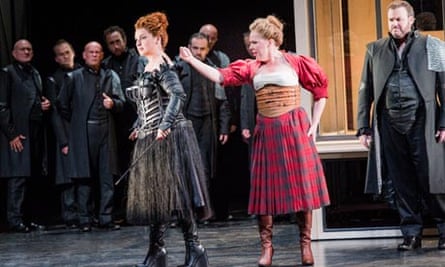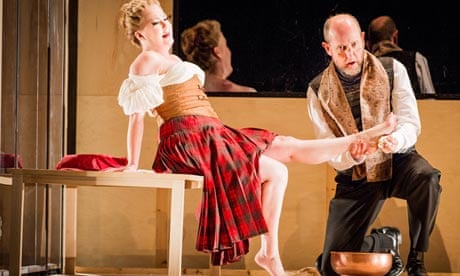Donizetti's operas about Tudor England play fast and loose with historical accuracy, but should they – and can they – be recontextualised out of period? It's a question inevitably raised by Welsh National Opera's stagings, which aim to challenge our assumptions about how Donizetti's Tudor trilogy should be approached.
Rudolf Frey's production of Maria Stuarda, the second of the series to be unveiled, deploys the same black-box set as its predecessor, Anna Bolena, while the costumes similarly hint at timelessness by eliding 16th-century England with 19th-century Europe, 1940s New Look and present day fetish wear. But the dissociation from a specific period also allows Frey to reinvent the opera as an introverted, symbolist psychodrama. Seriously misguided, it does the work few favours.
Frey views Judith Howarth's Mary and Adina Nitescu's Elizabeth as doppelgängers or alter egos. Two further boxes on stage, ruinously constricting movement throughout, indicate that each queen, in her way, is imprisoned – Mary by physical captivity, Elizabeth by the torture within her own psyche. The two women wear similar hairdos, and whenever Elizabeth looks in her mirror, she sees Mary looking back.

Unfortunately, Frey also views both women, not just Elizabeth, as sexually manipulative, which flies in the face of the score and shifts the balance of sympathies away from Mary and on to Bruce Sledge's Leicester, emotionally torn between the two queens and ultimately imploding under the stress. In an awkward departure from Donizetti, he shoots himself as Mary goes to the scaffold, which, even in the context of Frey's narrative tweakings, seems implausible.
More detrimental, perhaps, is the blurring of the opera's politics. The work itself is problematic in that it deals perfunctorily with the religious divide between the two queens. But Frey gives us little sense that the fate of nations and the lives of millions depend on the relationship between these women, irrespective of whether Donizetti's treatment is fictional.
Some fine individual performances don't really lift it. Graeme Jenkins' conducting has plenty of shape and bite. The great singing, easy and stylish, comes from Sledge. Howarth, whom we hear too infrequently these days, is all effortless coloratura and thrilling high notes. Nitescu, strident throughout, her voice barely under control, badly lets the side down, but Gary Griffiths does wonders with little as Elizabeth's revolting sidekick Cecil.

Comments (…)
Sign in or create your Guardian account to join the discussion